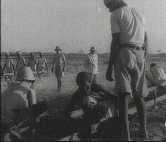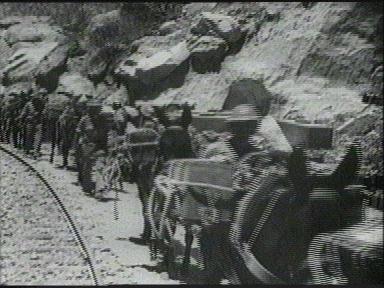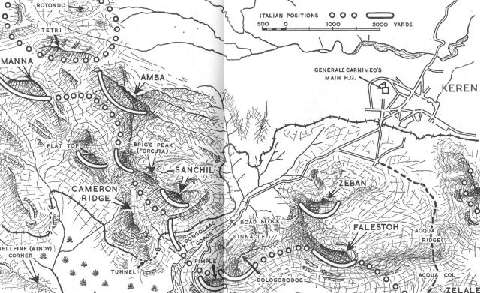Railway at War (original) (raw)
Railway at War
Eritrean Railway at War
The Eritrean Railway was enhanced to support the war between Italy and Ethiopia. Some construction or reconstruction was performed in the 1930s as depicted from pictures shown on Eritrean Multimedia:

It also was used by the British in their war against the Italians. Comments about the war and the Ropeway are contained on the Ropeway Page.
Photo courtesy of Eritrean Multimedia
Dave Engstrom* recently re-read most of "Eritrea 1941" by A.J Barker, a book he picked up in Rome in 1968 on his way back from Asmara. It's basically an account of the British campaign against the Italians in Eritrea, but it did mention the railway in a few places. The book is an Italian translation (published by Baldini & Castoldi, Milano 1968) of the original English version. The indented paragraphs below are Dave's retranslations back into English of excerpts from Barker�s book. The other material is Dave's comments or summary of the situation.
The British did have a fairly extensive rail system in the Sudan which they used for logistical purposes. The system was apparently a network of narrow-gauge, single line tracks dating from the 1890s. Dave has read somewhere they were built to support Kitchener�s campaign against the Mahdi. An important line for the British ran from Port Sudan inland to Haiya, where it split in two. From Haiya, one line went further inland to Atbara and then down to Khartoum and places beyond; the second line from Haiya went almost due South to Kassala, then on to Gedaref and other points, including Sennar, from where it looped back up to Khartoum.
Because of severe shortages, the Brits were hard pressed to supply their Sudanese outposts:
For a major saving in the field of transport in general, the boilers of coastal steamers and steam locomotives were stoked with charcoal briquettes and cotton seeds.
About three weeks after Italy declared war on June 10, 1940, the Italians took Kassala, on July 4. But it appears for some reason they had placed a limit of 40 km or so on their incursions into the Sudan, and they never really threatened the Sudanese rail line.
This greatly helped Platt: the loss of Kassala and the resulting interruption of the rail trunk between Haiya, Kassala, Gedaref and Sennar, which continued from there to Khartoum, was already serious enough in that it obliged reinforcements and supplies to pass through Atbara and Khartoum. The loss of Atbara would have been a grave disaster; that of Sennar would not have allowed the use of the Southern rail trunk.
In preparing for their offensive, the British shipped troops and materiel to Port Sudan through the Suez. Because of a change in orders, the crews of a tank squadron arrived after their vehicles.
When it was finally possible to reunite the crews and the heavy tanks, before sending them to the front lines it was necessary to effect modifications to the rail flat cars. Transport of the heavy vehicles to the front by truck certainly could not be considered. No one, however, knew what modifications had to made to the flat cars until the day the tanks arrived in the Sudan. (To the credit of the personnel of Sudan Railways the modifications were perfect: the rail cars that transported these enormous armored monsters operated without incident.)
On January 19, 1941, the British retook Kassala and on February 1-2, 1941, they captured Agordat and Barentu.
The victory at Barentu was as decisive as that of Agordat, and the conquest of the little town opened a magnificent route between the British railhead at Kassala and Agordat.
During this period, the Italian forces withdrew to Keren and the surrounding hills. On February 1 their commander ordered the blockage of the road and rail line to Agordat about 8 km outside Keren. But it appears that for some reason they didn't think of blowing up the rail tunnels on the Agordat-Keren line - there were at least two such tunnels, located only a few kilometers outside their defensive perimeter and the blockage point. Dave surmised that the Italians believed the main British assault would be more or less along the coast, from Port Sudan toward Massawa.
On February 3, the British forces began the battle of Keren, but were unable to penetrate the Italian defenses.
Because of the failure, the British had to crank up their logistical operations and prepare for a more difficult campaign against Keren. In regard to the railhead at Kassala, Barker says:
Far and away the most important place, from a strategic viewpoint, for the preparations for the approaching offensive was the railhead at Kassala, a magnificent objective for General Pinna�s bomber crews. However, and it seems strange, during the month of February Kassala was subjected to only one enemy incursion, and so traffic to and from the city continued uninterrupted at a pace not hoped for by even the most optimistic members of the British staff.
Later in the book, speaking of the logistical miracles accomplished by the British staff, Barker says "the rail line was extended about 70 kilometers beyond Kassala." Presumably this was toward Eritrea, which would mean the British rail line reached Teseney. [see Rob Dickinson's map where it is marked as Tessenai. The Eritrean Railway went 37 km past Agordat to Biscia].Barker didn�t show it on his sketch map of Western Sudan and Eritrea.
In regard to the line in Eritrea:
Able to rely only on their own resources, Platt�s administrative staff was forced to recognize that to be able to launch another offensive against Keren, the only solution consisted of a massive exploitation of available vehicles as well as the recently conquered railway, which linked Agordat to Keren, as soon as it could be put in operation.
Nothing was overlooked to ensure that the railway captured from the Italians functioned as it should. Foreseeing that during retreat the enemy would remove or destroy the rolling stock (cars, locomotives, etc), Platt's staff had thought of procuring diesel locomotives and cars whose trucks, used in the Sudan, had been substituted with ones adapted to the gauge used in Eritrea. As foreseen (sic), it was learned that the enemy had left behind a considerable number of usable freight cars, with which, when two diesel locomotives were brought from Atbara, it was possible to organize rail convoys, each of which consisted of three fully loaded cars (the maximum allowed) capable of reaching the bluffs of Keren. In place of the locomotives, 3/4 ton trucks were also used, arranged with the wheels astride the tracks, capable of towing a single fully loaded flat car to the front line.

From Eritrea 1941
Speaking specifically of the hill over the rail tunnel closest to the front line, and in reference to the first attack on February 3, Barker says:
The attempt to open a breach in the defenses around Keren had failed, but the ledge over the rail tunnel, Cameron Ridge, would prove to be of enormous importance, even if its conquest required the sacrifice of many lives.

From Eritrea 1941
The author goes on to say:
The railway was also used for night-time transport of materiel and supplies destined for Cameron Ridge, employing a single flat car carrying three or four men which arrived at the entrance of the tunnel under the hill. Once unloaded, the cars descended freewheeling, pulled by their own weight, while their often dangerous speed was controlled, for better or worse, by men operating the hand brake. On the return trips, the wounded were loaded on the cars, which spared them the suffering of being transported by stretcher, particularly difficult along the steep mountain paths. The life of these stretcher bearers was less dangerous and tiring, and many human lives were thus saved.

From the Italian version of Eritrea 1941
The rail line near the tunnel of Cameron Ridge
On March 15, 1941, the British resumed the attack on Keren. Twelve days later, on March 27, they took the city. After the loss of Keren, which was characterized as the end of Italian East Africa, things went very fast in Eritrea � the British were in Asmara 4 days later on April 1 and in Massawa by April 11. Although it was another month until the capture of the Duke d�Aosta and a sizable Italian force at Amba Alagi, the real end was Keren.
Apart from the indirect reference, above, to the British having to put the Agordat-Keren line back into operation, the only real reference to what must have been significant damage to the rail line was the following, which occurred during the fighting at Keren:
The Wellesleys that bombed the rail line leading to Asmara struck a train loaded with munitions destined for the front, and the din of the explosion added to the infernal sounds of the guns at Keren and the surrounding area.
It sounds as if for the most part the rail line got through it all in relatively good condition. Though Dave and I don't understand why the Italian forces didn't obliterate the tunnels. The one under Cameron Ridge, mentioned above, turned out to be a real key to the British being able to seize some important hills, nicknamed Rail Bumps and Railway Ridge, which in turn led to the capture of other crucial ground. Barker tells the following little story:
To convert the rail tunnel into an approach route to_Railway Bumps_ and Railway Ridge, the Indian units of Beresford-Peirse�s sappers had begun to remove the trucks loaded with rocks with which the Italians had blocked the road, and by the morning of March 24 a gap had been opened. Because it was feared that the far end of the of the tunnel might be covered by an enemy machine gun, such an approach route could be very dangerous, but for once Lady Luck smiled on the attackers. The Italians were convinced that any attack coming from that direction would be effected by direct ascent of the gorge, and they had therefore excluded the possibility of using the tunnel, an undertaking considered mad. Just as it was thought to be by the Englishmen who were going through the tunnel. The night of March 24, a patrol of officers advanced stealthily in the tunnel and exited it following the rail line to make sure the Italians weren't aware of the clearing work. The situation, however, appeared quiet and, as a result, the first and important preparatory phase of the operation could be considered perfectly successful.
During the previous day, the Highland Light Infantry(HLI) and the Baluchis had entered the tunnel. The HLI who had to launch the attack had arrived in the morning and had passed the rest of the day in the cool air of the tunnel trying to kill time chatting and singing. Rees, who was with them, was afraid the noise made by the soldiers could be heard by the Italians, and he went up to the tunnel exit for a look around. His justifiable fears quickly vanished; the noise didn't reach the entrance and outside everything appeared quiet. Consequently, around 0300, after swallowing the last drops of tea and rum, the two companies of HLI set off on tip toe and 15 minutes later reached the tunnel entrance. There followed a moment of high drama; when the enemy opened fire, the troops had orders to scatter to the right and left of the rail line. The intelligence on the Italian defenses was so vague it could not be ruled out that on leaving the tunnel they would be welcomed by a rain of bullets and hand grenades. Everything, however, went perfectly; the_HLI_met no opposition; the surprise was complete.

From the Italian version of Eritrea 1941
The Mussolini Bridge.
Some of the crossmembers of the bridge, which crosses the dry river bed of the Barca River 10 kilometers from Keren, were blown up.
From the Italian version of Eritrea 1941
View of a damaged section of the bridge with sappers and bomb disposal experts intent on repairs.
From an additional book on the warn that Dave Engstrom picked up on the way home: La Guerra dei Sette Mesi (The Seven Month War) by Luigi Pignatelli.

This picture was likely taken at Devil's doors.
*I converted Dave's commentary to the third person to avoid confusion with it being me talking. I have present the material pretty close to Dave's words. I will do this with anyone's submissions unless I just use a short quote. I concur with editorial comments that Dave has made. Dave was not able to find information on the line from Kassala to Tessenai. I have linked to a map that shows it.
Sometime after cessation of hostilities, a number of the civilians were evacuated from Asmara via train and then ship.
| Who | What | Why | When | Where |
|---|



